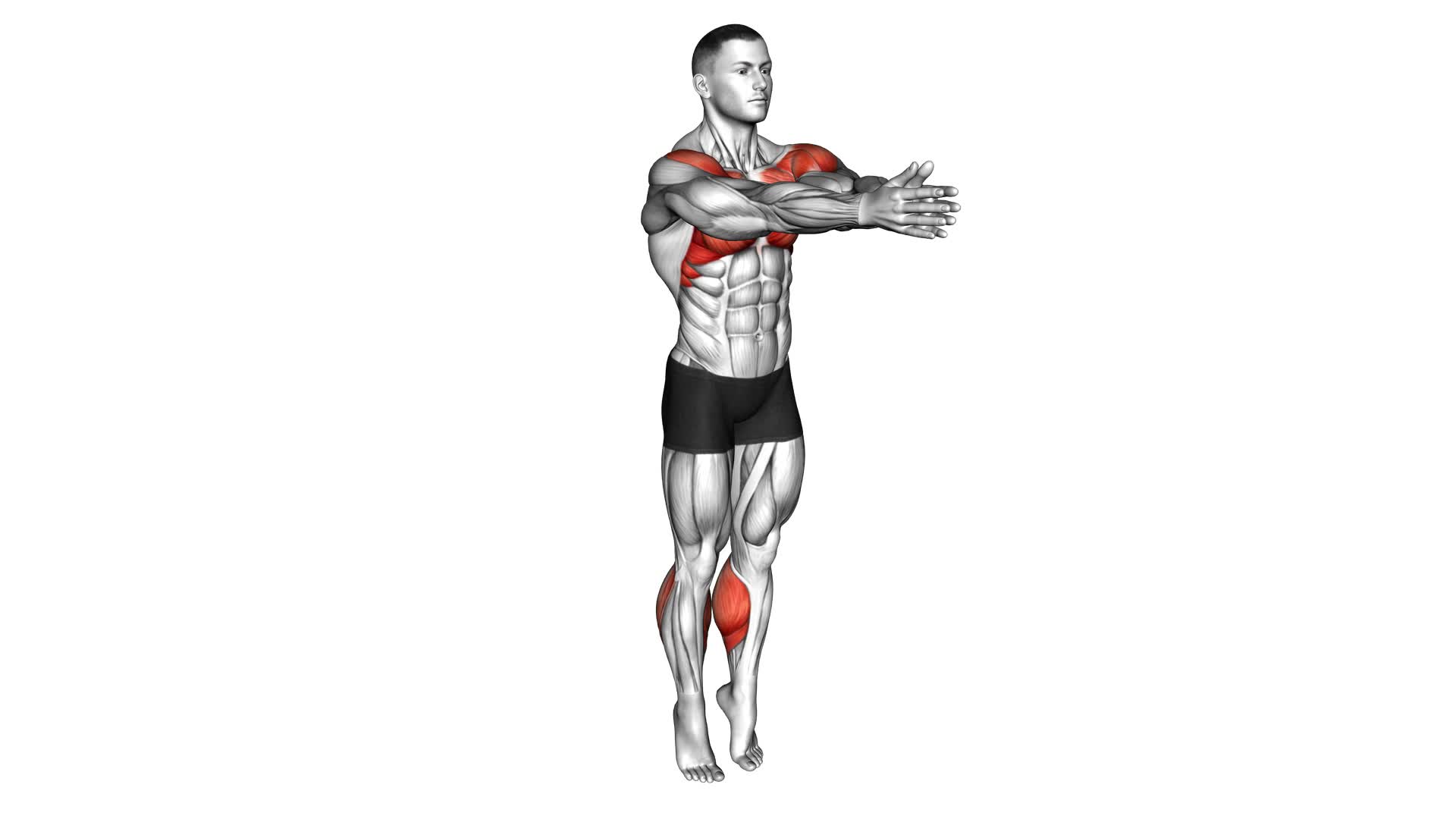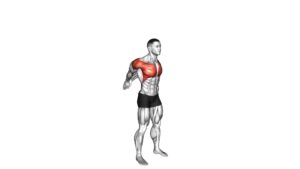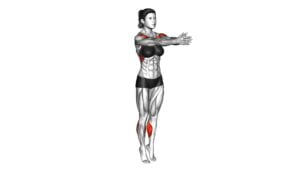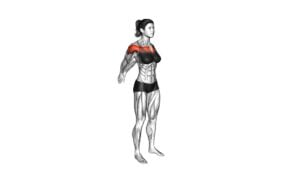Calf Raise Clap (male) – Video Exercise Guide & Tips

Want to strengthen and tone your calf muscles? Look no further than the calf raise clap exercise!
Watch This Exercise Video
This video exercise guide will show you the proper form and technique, as well as variations to challenge yourself.
Learn how to avoid common mistakes and incorporate calf raise claps into your workout routine for maximum results.
Get ready to feel the burn and take your calf game to the next level!
Key Takeaways
- Calf raise clap exercise strengthens and tones calf muscles.
- It enhances explosive power and improves athletic performance.
- The exercise engages core muscles and improves balance and stability.
- Variations like single-leg calf raise and weighted calf raise can challenge calf muscles further.
Benefits of Calf Raise Clap Exercise
Improve your calf strength and explosiveness with the Calf Raise Clap exercise. This exercise is a great way to target your calf muscles and enhance your explosive power training. By incorporating the Calf Raise Clap exercise into your workout routine, you can experience improved calf strength and power.
The Calf Raise Clap exercise specifically targets the muscles in your calves, helping to build and strengthen them. As you rise up onto your toes, you engage the calf muscles, forcing them to work harder. This increased workload helps to build muscle and improve overall calf strength.
In addition to improved calf strength, the Calf Raise Clap exercise also helps to enhance explosive power. This exercise involves a quick and explosive movement, as you push off the ground and clap your hands together at the top of the movement. This explosive action helps to train your muscles to generate power quickly, improving your ability to jump higher or sprint faster.
Incorporating the Calf Raise Clap exercise into your workout routine can have a significant impact on your calf strength and explosiveness. By focusing on these areas, you can improve your athletic performance, whether you're a runner, basketball player, or simply looking to enhance your overall fitness level.
Proper Form and Technique
To perform the Calf Raise Clap exercise with proper form and technique, focus on engaging your calf muscles as you rise up onto your toes and explosively clap your hands together at the top of the movement. Maintaining proper form is crucial to ensure that you're effectively targeting your calf muscles and minimizing the risk of injury.
One common error to watch out for isn't fully extending your ankles at the top of the movement. Make sure to rise up as high as possible onto your toes, squeezing your calf muscles. Another mistake is using momentum to lift yourself up instead of relying solely on your calf muscles. Remember to control the movement throughout, using a slow and controlled pace.
If you find the Calf Raise Clap exercise too challenging, there are modifications you can make to gradually build up strength. Start by performing the exercise without the clap, focusing on the upward movement and the squeeze at the top. You can also hold onto a stable object, such as a wall or a chair, for support until you feel more comfortable.
Now that you're familiar with the proper form and technique of the Calf Raise Clap exercise, let's explore some variations to challenge your calf muscles even further.
Variations to Challenge Your Calf Muscles
To further challenge your calf muscles, you can incorporate different variations of the Calf Raise Clap exercise. These advanced calf raise variations are designed to improve calf strength and flexibility.
Here are three variations you can try:
- Single-Leg Calf Raise: Instead of performing the exercise with both feet, raise one foot off the ground and balance on the other foot. This variation adds an extra challenge to your calf muscles as they've to work harder to maintain balance.
- Weighted Calf Raise: Hold a dumbbell or a weighted plate in one or both hands while performing the calf raise. The added resistance will increase the intensity of the exercise and stimulate further muscle growth.
- Plyometric Calf Raise: Incorporate explosive movements into your calf raises by jumping off the balls of your feet and landing softly. This plyometric variation helps to develop power and explosiveness in your calf muscles.
By incorporating these advanced variations into your calf raise routine, you can target your calf muscles in new and challenging ways, promoting further strength and flexibility gains.
Now that you know how to vary your calf raises, let's move on to the next section, where we'll discuss common mistakes and how to avoid them.
Common Mistakes and How to Avoid Them
To prevent common mistakes during calf raises, it's important to be mindful of your form and technique. One common mistake is using too much weight. While it may be tempting to load up the calf raise machine, using excessive weight can lead to improper form and increased risk of injury. Instead, start with a weight that allows you to perform the exercise with proper form and gradually increase the weight as your strength improves.
Another common mistake isn't fully extending your ankles at the top of the movement. Many people tend to stop short, missing out on the full range of motion and reducing the effectiveness of the exercise. To avoid this, make sure to fully extend your ankles and raise up onto your toes as high as possible.
Additionally, it's important to avoid bouncing or using momentum to lift the weight. This not only takes away from the targeted muscle engagement but also puts unnecessary stress on your joints. Instead, focus on controlled and smooth movements throughout the exercise.
Lastly, neglecting proper breathing technique can also hinder your calf raise performance. Remember to exhale as you raise up onto your toes and inhale as you lower back down.
Incorporating Calf Raise Clap Into Your Workout Routine
To incorporate the Calf Raise Clap into your workout routine, it's important to follow proper form and technique, as discussed in the previous section. Once you have mastered the correct execution, you can integrate this exercise into your fitness regimen to reap its benefits.
Here are three reasons why incorporating the Calf Raise Clap into your workout routine can be beneficial:
- Effective Cardio Workouts: The Calf Raise Clap is a dynamic exercise that engages multiple muscle groups, including the calves, quads, and glutes. By incorporating this exercise into your routine, you can elevate your heart rate and enjoy the cardiovascular benefits of a high-intensity workout.
- Enhancing Lower Body Strength and Stability: The Calf Raise Clap targets the muscles in your lower body, particularly the calves. By regularly performing this exercise, you can strengthen and tone your calf muscles, improving your overall lower body strength and stability.
- Plyometric Training: The explosive nature of the Calf Raise Clap makes it a great plyometric exercise. Plyometric training helps improve power, speed, and agility, making it an excellent addition to any workout routine.
Frequently Asked Questions
Can the Calf Raise Clap Exercise Help Improve Ankle Stability?
Yes, the calf raise clap exercise can indeed help improve ankle stability.
By performing this exercise, you aren't only strengthening your calf muscles but also challenging your ankle stability.
This exercise requires you to balance on the balls of your feet while clapping your hands together.
It helps to improve the strength and stability of the ankle joint, which can be beneficial for various activities and sports.
Additionally, there are variations of this exercise that specifically target ankle stability, further enhancing its effectiveness.
What Is the Recommended Number of Sets and Repetitions for the Calf Raise Clap Exercise?
For the calf raise clap exercise, the recommended number of sets and repetitions can vary depending on your fitness level and goals. However, a good starting point is 3 sets of 12-15 repetitions.
This exercise not only targets your calf muscles, but it also helps improve ankle stability. By performing calf raise claps regularly, you can strengthen your calves and enhance the stability of your ankles.
This can be beneficial for activities that require balance and agility.
Is It Normal to Experience Calf Muscle Soreness After Performing the Calf Raise Clap Exercise?
It's not uncommon to experience calf muscle soreness after doing the calf raise clap exercise. This exercise targets your calf muscles and can help improve their strength and stability.
To maximize the benefits and minimize discomfort, make sure you're using proper form for the calf raise clap. Engage your core, keep your back straight, and lift your heels as high as you can while clapping your hands together at the top.
Can the Calf Raise Clap Exercise Be Beneficial for Individuals With Knee Pain or Injuries?
The calf raise clap exercise can be beneficial for individuals with knee pain or injuries. By strengthening the calf muscles, it helps to provide support and stability to the ankles, which can alleviate some of the pressure on the knees.
Additionally, this exercise promotes ankle stability, which is crucial for maintaining proper alignment and reducing the risk of further knee injuries.
Incorporating the calf raise clap into your workout routine can help improve both your calf strength and overall knee health.
Are There Any Modifications or Alternatives to the Calf Raise Clap Exercise for Individuals With Limited Mobility or Physical Limitations?
If you have limited mobility or physical limitations, there are adaptations and modifications you can make to the calf raise clap exercise.
Instead of clapping, you can simply raise your heels as high as you can, focusing on engaging your calf muscles.
Alternatively, you can perform seated calf raises using a chair or bench for support.
These modifications allow you to work your calf muscles while accommodating your specific needs.
Conclusion
Incorporating calf raise clap into your workout routine can be a great way to challenge your calf muscles and improve their strength and endurance.
By maintaining proper form and technique, avoiding common mistakes, and exploring variations of the exercise, you can maximize the benefits and avoid injuries.
So, why not give calf raise clap a try and take your calf muscles to new heights!

Author
Years ago, the spark of my life’s passion ignited in my mind the moment I stepped into the local gym for the first time. The inaugural bead of perspiration, the initial endeavor, the very first surge of endorphins, and a sense of pride that washed over me post-workout marked the beginning of my deep-seated interest in strength sports, fitness, and sports nutrition. This very curiosity blossomed rapidly into a profound fascination, propelling me to earn a Master’s degree in Physical Education from the Academy of Physical Education in Krakow, followed by a Sports Manager diploma from the Jagiellonian University. My journey of growth led me to gain more specialized qualifications, such as being a certified personal trainer with a focus on sports dietetics, a lifeguard, and an instructor for wellness and corrective gymnastics. Theoretical knowledge paired seamlessly with practical experience, reinforcing my belief that the transformation of individuals under my guidance was also a reflection of my personal growth. This belief holds true even today. Each day, I strive to push the boundaries and explore new realms. These realms gently elevate me to greater heights. The unique combination of passion for my field and the continuous quest for growth fuels my drive to break new ground.



